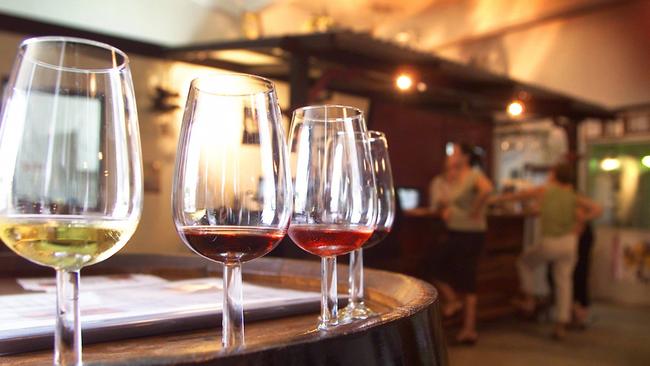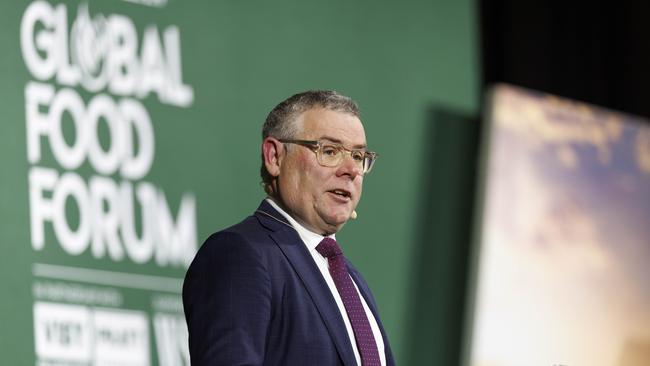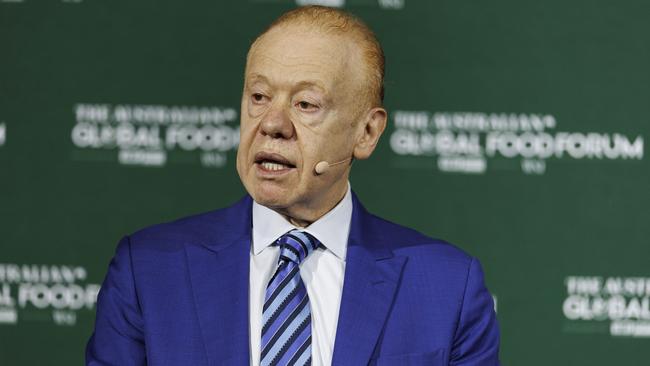
It was a public relations exercise designed to highlight the fact that China had dropped tariffs of more than 200 per cent on imports of Australian wine which killed a once booming export market of more than $1bn a year.
But while China clearly saw the exercise as a signal from the top that it was reopening its market for Australian wine, it was also a reminder of the potential of politics to play a role in exporting to China.
As Australian producers of wine and other agricultural products such as barley and beef return to the Chinese market with the lifting of tariff and non-tariff barriers over recent months following two years of improved relations with China under the Albanese government, they are also wary of the challenges of the China market.
The dual themes of the huge potential of the China market for Australian agriculture and importance of not having all eggs in the China basket was one of the key themes of the 12th Global Food Forum held in Brisbane on Wednesday.

Australia exports more than 70 per cent of its agricultural products and China is one of the world’s largest single markets for a lot of our products.
Federal Agriculture Minister, Murray Watt, told the forum that Australia had been “notching up some wins” lately including the resumption of trade with China.
“The stabilisation of our relations with China is delivering real dividends,” he said, noting that restrictions on imports of barley, timber, cotton, hay and wine had been removed.
He said wine makers had already sold $220m in wine to China since it lifted tariffs on Australian wine earlier this year – four times the value of exports of Australian wine exports to China in 2021, 2022 and 2023 combined.
But he said there were also risks in having too much concentration on exporting to any one market.
“We are also working to diversify our markets,” he said of the federal government.
This included increasing focus on exports to the UK, India, Southeast Asia and the Middle East.
He said the government was working on improving access to markets in India and negotiating a free trade agreement with the UAE as a way to get into the Middle East market.
It was a similar theme made by Visy chairman Anthony Pratt at the forum.
He welcomed the fact that Australia’s food exports had more than doubled from $29bn to $59bn since the first Global Food Forum in 2013 with high-value, protein-rich exports like meat leading the pack at $18bn of exports last year.
Australia’s beef exports to China have grown by 200 per cent since the first forum, he noted.
But while China had been a great customer, he said “Australia has done what any successful exporting nation does to secure its future – continue to find new customers so it’s not totally reliant on any one”.
“There has clearly been a pivot towards other markets for some of our export goods,’ he said, pointing to the fact that Australia now had 18 FTAs in place, two-thirds of which had been achieved since the first forum in 2013.

Chinese buyers make up 23 per cent of Australia’s wheat exports, 22 per cent of beef exports and 19 per cent of Australia’s meat excluding beef.
In the 2022-23 financial year China bought $7.3bn worth of these goods – more than double the second biggest customer Japan which bought some $3.4bn in meat and wheat over the same period.
Companies at the forum already in the China market included infant formula company Bubs, Costa Group which grows blueberries in China’s Yunnan province and exports citrus products from Australia to China. and South-Australian based Hugh Hamilton Wines which has resumed sales to China.
But they made it clear that the events of the past few years in terms of trade barriers imposed by China had delivered some sobering lessons for those who once saw China as being a market paved with gold for Australian food exporters.
Taps turned on overnight can also be turned off overnight.
While the Chinese trade barriers have delivered some serious blows to exporters, in sectors such as wine, barley and lobster, they have also produced a much more resilient approach to exporting – an emphasis on the importance of other markets even if they are smaller than China’s. Japan, Vietnam and Indonesia are markets getting additional attention.
Indeed if anything even small exporters like Hugh Hamilton wines have proved themselves remarkably agile in readjusting their export sites to unforeseen market changes.
Hugh Hamilton chief executive Mary Hamilton did not pull her punches in her comments, despite her resumption of sales to China.
“It was a real error on behalf of the Australian wine industry to put all their eggs in the China basket,” she said. “We did it at a government level. We did it at a national level. We did it as big companies, as small companies, as regional bodies.
“We put all of our eggs into China, and I think that was a big mistake. We’ve got to always look for a much more diversified view of exports.
“You put your fishing rod into the part of the river where the fish are. It’s very tempting to just stay there, but you’ve actually got to move the boat around a bit, and I think we didn’t do enough of that.”
China, she said, would “continue to be a very tempting big juicy red apple” for Australian agricultural and food exporters.
“There’s a temptation that we’re all going to flock there again,” she said.
“And I think we should be there, but we should do it in a more considered way.”






When Chinese Premier Li Qiang visited Australia recently he dropped into to see Penfolds’ McGill wine growing estate in South Australia.